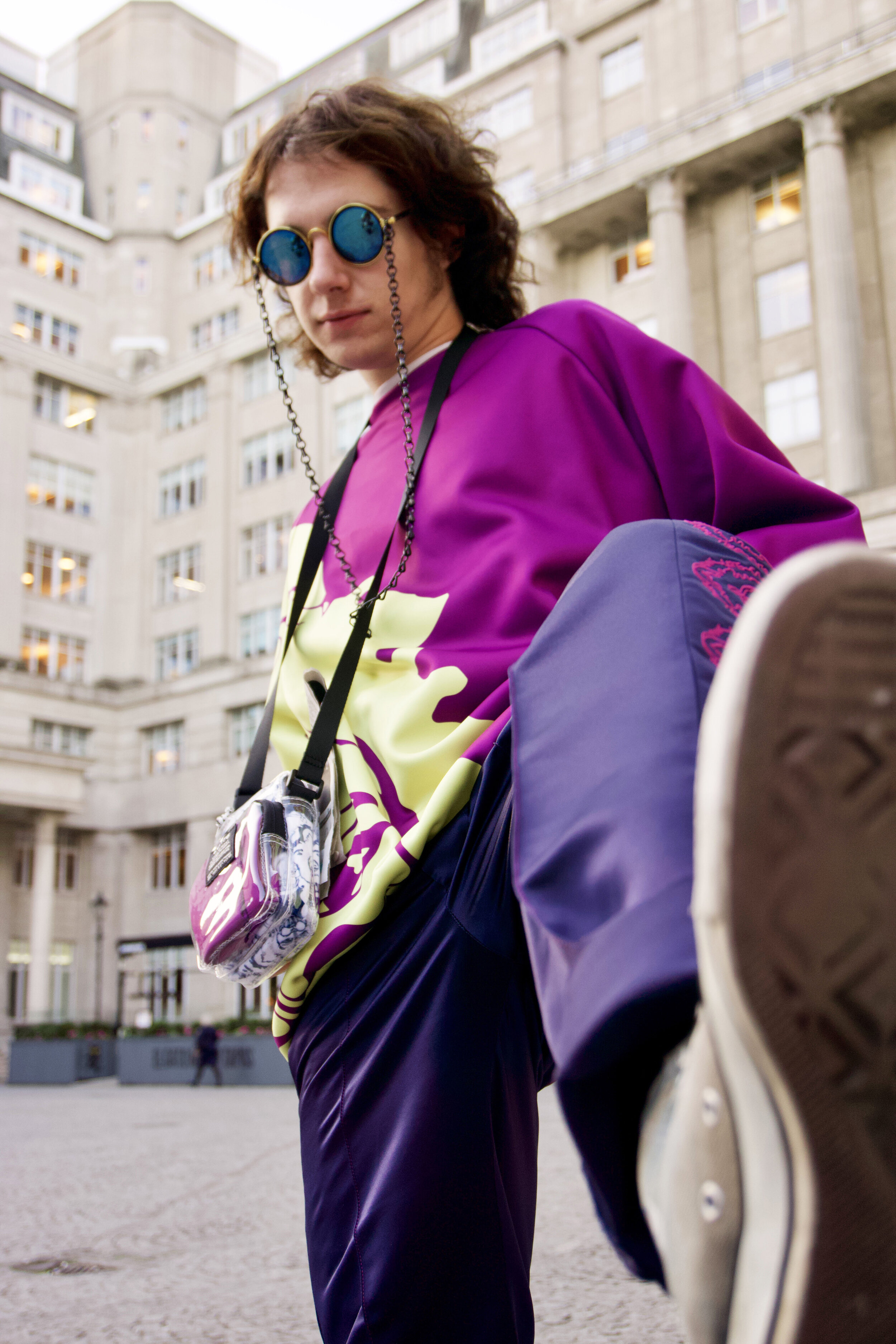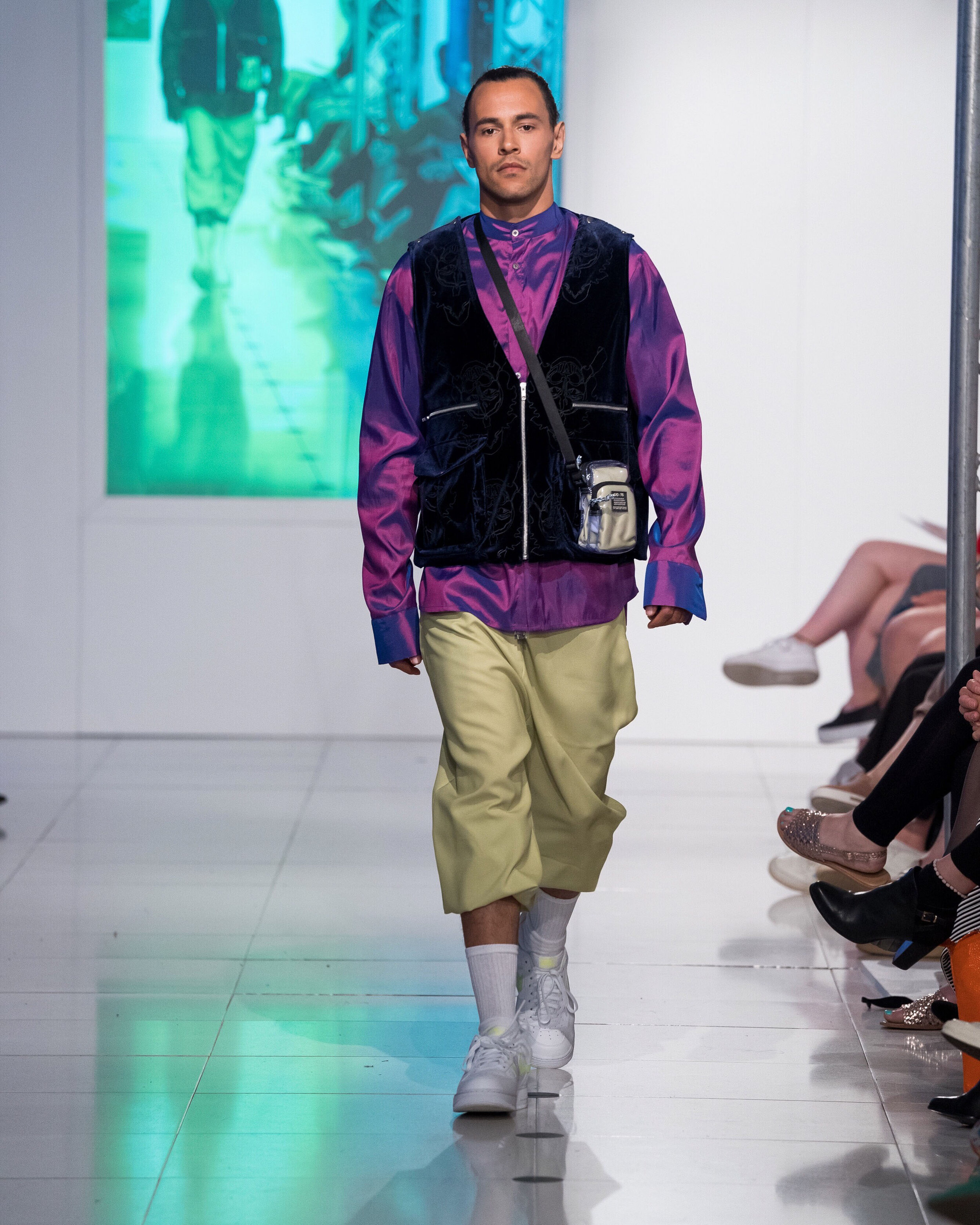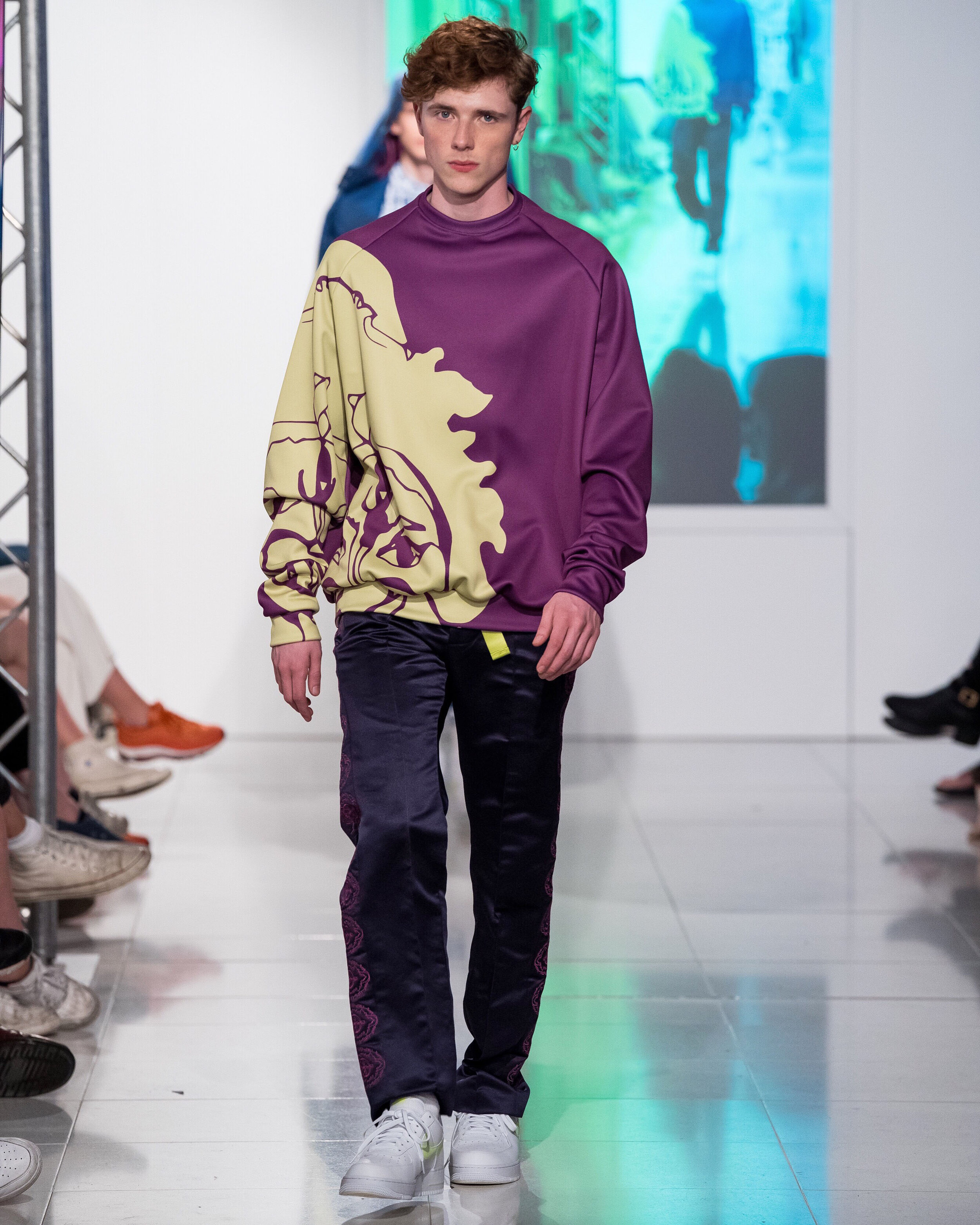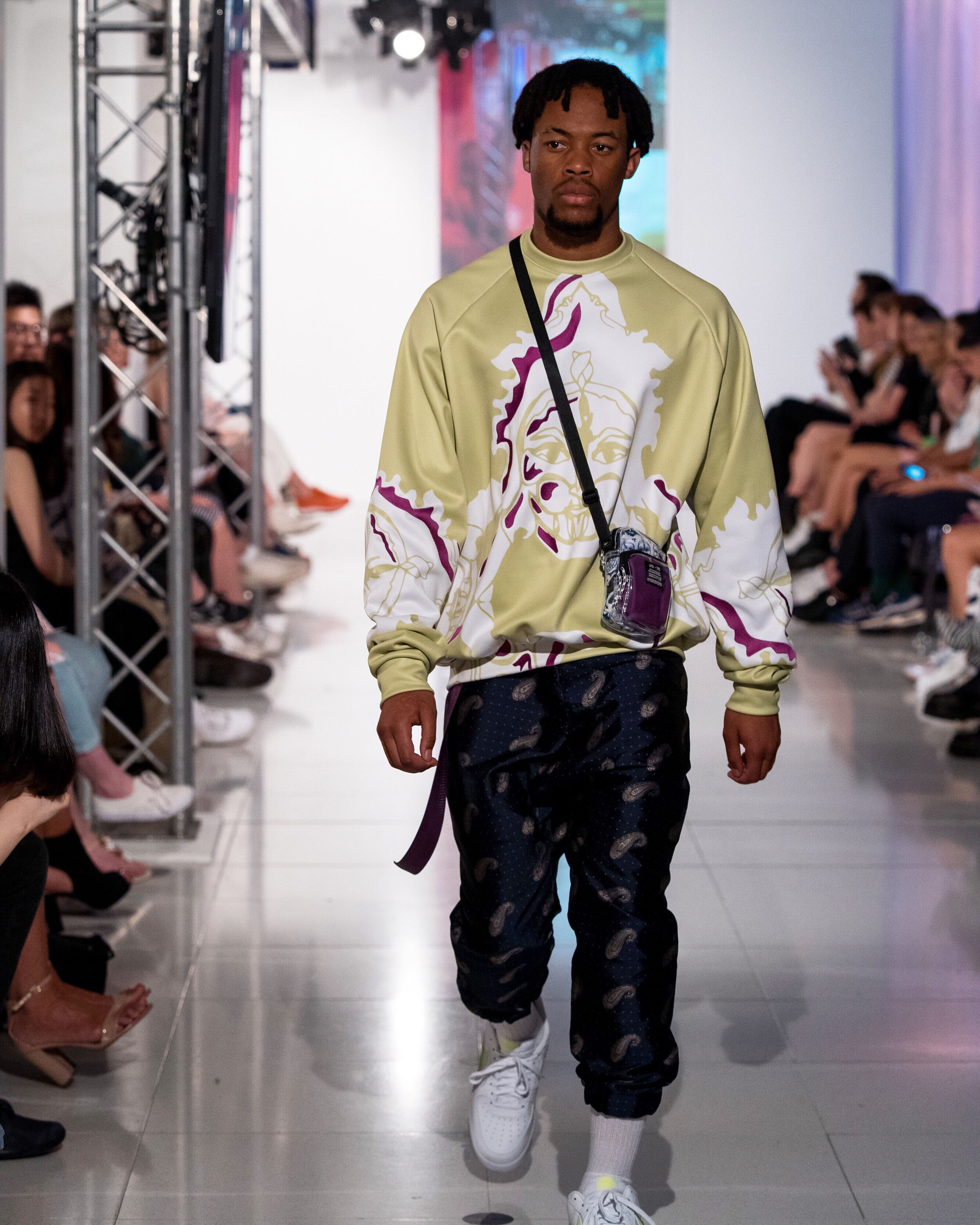Meet Alisha Kumar, a fashion design graduate from Nottingham Trent University. Alisha’s work is inspired by her Punjabi heritage and the culture clash of traditional Sikh clothing with sportswear. Exploring the idea of heaven, and what it means to her, Alisha’s collection is called “From God’s Own Junkyard.” “The contrast of contemporary and tradition continued throughout my prints and colour palette, using deep tonal colours such as purple and navy with the bashful green and pink hues which I extracted from my initial imagery,” she says. “Overall, I wanted my collection to be a celebration of my Indian heritage and its rich and vibrant culture, but with a fun and playful twist.” Read more about Alisha’s work below!
What is the most valuable thing you have learnt at university?
I can proudly say that one of my most valuable qualities I have learnt as an artist is being a ‘critical thinker’. University taught me that. Throughout my years at Nottingham Trent University, I was lucky enough to have access to classes that studied ‘Design, Context and Culture’ within fashion and society. These classes quickly became my favourite as I was encouraged to explore the wider context of art and design and how it impacted the world around us. The classes almost ‘trained’ my mind to think critically and how I could translate important ideas into my creative practise. My tutors always encouraged me to think deeply about my work and highlighted the importance of using my creativity as a platform to send personal and important messages to my audience.
How will your work impact those around you? What are the messages you are trying to convey? How do you intend to be sustainable and thoughtful within your work? These questions stuck by me like a mantra for those three years, constantly urging me to push the depth and meaning behind my work and myself as a person. Critical thinking taught me the importance of exploring my cultural background and gave me the confidence to celebrate what I most love about myself; my ethnicity, my upbringing and my unique cultural experiences. University taught me to use my creative platform to teach those around me about my rich Indian culture, and the exciting ways this integrated within modern fashion and society.
I aimed to create almost an element of escapism for the wearer, and an opportunity to pause their world for a minute while they delved into mine. I tend to use abstract prints and patterns as an almost ‘signature’; a medium to engage the mind and exhibit my own contrast between traditional Indian notions and a playful homage to modern culture. These important concepts within my work meant that there was always a personal story in each of my creations, and (although very daunting), offered a piece of myself to the outside world. Without encouragement from my tutors at university, I would not have developed the skill to think deeply and critically, which I think is one of the most important elements of fashion and society today.
Tell us about your most recent project.
I have called my most recent project ‘From God’s Own Junkyard’, in relation to the self-titled exhibition I visited to obtain my initial research. This title is also a play on words as I delve into my own personal idea of ‘heaven’. This inspiration came from a visit to God’s Own Junkyard, a neon light/ sign exhibition in London. I was instantly captured by the visually engaging experience the hundreds of signs created, the ‘offsetting’ of the lights and reflections along with the colours used created such an ethereal, idyllic environment. I wanted to make my collection personal to me and to tell a story, and a massive part of my idea of ‘heaven’ is my cultural background and Sikh belief. I loved the contrast of the pop-art like neon signs with traditional imagery of Gods and deities from my Punjabi heritage. When I visit the Sikh temple back in my hometown of Leicester, people come in wearing traditional Sikh wear but layered with a sporty puffer jacket and air max trainers for comfort.
I have always found this functional combination humorous and bashful, and thought it would be an interesting starting point to clash and combine Indian cultural prints and patterns with sportswear silhouettes. I have always been interested in technical sportswear, so I really enjoyed the development of this collection, combining ethnic silhouettes with contemporary technical fabrics. I focussed on using luxurious and tactile fabrics e.g. velvet and soft shell jersey as this engaged the wearer’s senses and linked to the ‘heaven-like’ experience I set out to explore. The contrast of contemporary and tradition continued throughout my prints and colour palette, using deep tonal colours such as purple and navy with the bashful green and pink hues which I extracted from my initial imagery. Overall, I wanted my collection to be a celebration of my Indian heritage and its rich and vibrant culture, but with a fun and playful twist.
What form does your project take?
For this project, I created a collection of 4 outfits, which I pattern cut and manufactured myself. I experimented with a variety of different techniques, with the intention of creating as much sensory engagement with the wearer as possible. This led to exciting developments with laser cutting and machine embroidery, as well as the offsetting of digital prints and imagery. One of my favourite pieces was the ‘Kali Mata’ Utility vest. This was made in a luxurious navy velvet which I had engraved ‘Kali Mata’ patterns onto beforehand, creating a subtle repeat pattern. Kali Mata is the Indian Goddess of Creation, Destruction and Power, and a deity I have been surrounded by throughout my life. My idea of ‘heaven’ consists of Kali Mata’s presence, and I wanted to showcase this throughout my designs. All of my prints and patterns were developed from different ideas of what Kali Mata means to me and her influence throughout my childhood growing up in Leicester.
During this project, I was lucky enough to collaborate with many talented artists to create a promotional fashion film, which became one of my favourite finished works within my collection. My vision for the film was to bring to life the ethereal, idyllic heaven- like experience that I felt when visiting the ‘God’s Own Junkyard’ exhibition. This involved using deep tonal colours for lighting, e.g. deep pinks and purple. However, I also wanted to showcase the fun and playful element to my collection, as it was the contrast between traditional Indian ‘God’ like figures and modern pop culture that made my work personal to me. We did this by creating a fun and carefree environment for the models, dancing to music, channelling their energy and simply enjoying themselves. I collaborated with graphic designers, lighting designers and film students from Birmingham City University. It was a great experience and I believe the fashion film really captures the perfect balance of ‘ethereal’ and ‘playfulness’ that I had in mind for this project. Another important element of this project was my dissertation.
Although a separate university module, I used my dissertation in relation to my collection to debate the topic of cultural appropriation in modern culture and society. I had the opportunity and great resources to create a collection of garments in celebration of my Indian culture, but I also wanted to use my written voice to tackle and debate the topic of appropriation vs appreciation, using my personal experiences to lead the debate. Within this written work, I put forward the idea that cultural appropriation within fashion evolved from the western individual’s privilege and ignorance, an obliviousness to the offense they may be inflicting on minority cultures. I explored the reasons as to why western ignorance existed, for example looking at the deep need for authenticity and individuality within a mass consumerist society. I also talked about ways in which cultural appropriation and ignorance can be tackled, firstly by educating yourself about the culture you may be taking inspiration from, as well as missioning to educate your audience.
Please see below a snippet of my dissertation: “The main reason for my investigation leans on the fact that I can only hear “What’s that dot on your forehead?” or “I had henna like yours at Forbidden Forest” so many times before I am frequently questioning the obliviousness of these individuals around me. Growing up as a Sikh woman in a world dominated by the white individual, hearing comments like these don’t come as a surprise. The few that have taken be aback, however, are the comments along the lines of “I always forget you’re brown!” or “I don’t see race”, as if this blatant ignorance of my cultural background is in some way showing that they have mastered the art of rejecting the politics of division.” I think, especially in light of recent events, racial and cultural ignorance within fashion brands have become topics at the forefront of many individual’s minds. Conversations are finally being had, people are no longer staying quiet, people are finally realising the power of their voices. For the first time in my life, I feel united with those who have always appeared to be a step above me on the ladder of success. I am hopeful that proper representation of Black and Asian communities will be shown in modern fashion. Thoughtless appropriation will be replaced with celebrations of culture, a platform to educate, and a diversity of models and creatives within the industry.
How have you evolved as a young creative while studying / working?
I think I have evolved so much as a young creative. I am more confident with showcasing my work and my personal story to the outside world. Working many internships within the industry has brought a new-found love for collaborative work and working as a team. I think it is so important to network with like-minded creatives, as you are able to learn so many skills from those around you. Collaborating is also a great way to boost your creativity and explore new avenues within your work that you may never have tried by yourself. Throughout a variety of work experiences, I have been fortunate enough to explore different forms of fashion media. Some of my interests outside of fashion design include digital illustration and portraiture, and graphic design. I believe it is so important to develop skills outside of your main field, as it enables you to work from different angles within the industry and it’s a powerful feeling when you are able to incorporate all your different interests into one project.
My current employment as a fashion designer has been the most challenging but also empowering experience of my life so far. I have evolved so much in so little time, I have gained skills I didn’t even know existed until working full time! Working within a team has always been my favourite way of working, so it is great to know that I have a community of colleagues within the industry who are always there to support me and help me grow. As someone who is constantly wanting to learn, I am always putting myself forward for opportunities to present new design ideas, lead team meetings and confidently give my opinion about fabrics and designs. I think the business side of fashion design is sometimes forgotten about, however, learning to market yourself as a designer and present yourself professionally, as well as going out of your way to seek new business ventures within fashion is one of the most significant elements of a successful brand. Before identifying as a young designer, I identify myself as a proud Punjabi woman. My culture and heritage is a massive part of how I brand myself and present myself within the industry.
What are the messages and themes behind your project that you want people to take away? Do explore any topics like diversity, sustainability or politics in your work?
This project is important to me as I wanted to just completely and whole heartedly celebrate my Punjabi background and upbringing. I wanted to pay homage to the vibrant Punjabi community in Leicester, to the countless visits to the Holy Bones Temple, to the years of celebrating Vaisakhi and feeling a sense of unity as thousands paraded through the streets of our hometown. I wanted to show the world the energy and life of my community through the eyes of a 3rd generation Punjabi woman, which meant highlighting the contrast between Sikh tradition and modern pop culture which have intertwined throughout my whole life. I hope to create an emotional and sensory experience with the colours and patterns and prints used throughout my collection and I hope to show a light-hearted and playful element to my project. My aim is to help create a stronger emotional attachment between the wearer and the garment, increasing the product’s longevity and effectively slowing down the cycle of fashion.
The underlying message within my work is to example how to celebrate minority cultures within the fashion industry without appropriating them. It is difficult as a person of colour to see major respected fashion brands exploit your culture, take meaningful objects and traditions and profit from them. I wanted to take ownership of my identity and use my voice to help bring diversity and inclusivity within the fashion industry which is still a major problem. As a young designer, I stress the importance of education before taking inspiration, and using members of minority cultures to represent your brand. It is great to see these issues coming to light and igniting important conversations, in the hope to actively diversify and commemorate people of colour within fashion and society.
What’s an aspect of the fashion industry that you’re passionate about fixing or having a positive impact on?
I believe it is our responsibility as young designers to create a slow fashion environment, built on zero waste design, thoughtful manufacturing and meaningful products. I hope the future of fashion will include less seasonal fashion shows and more made to measure, customised clothing, personal to each customer rather than mass produced for millions. I feel very passionate about the importance of creating clothing with emotional longevity, using personal stories and narratives to take the consumer on a journey when wearing garments, creating an ‘experience’ rather than just a fashion piece. In today’s world of fast fashion, the story behind clothes is often lost in the process of manufacturing and never understood by the wearer. I aim to prolong the lifetime of my projects by creating an emotional connection between the wearer and my garments.
The personal stories behind my prints, colours and silhouettes adds character to each garment and as a result will lead to the consumer holding onto it for longer, slowing down the viscous cycle of fashion and also minimising the negative impact the fashion industry has on the environment. However, I also feel that we can’t mend our physical environment without mending our human environment. My goal as a designer is to continue pushing the boundaries of fashion and to build a bridge between fashion and culture. It is important for me as a Punjabi woman to capture the culture in my life and translate that into my designs. I hope that one day representation of Indian designers and cultural celebrations within fashion is no longer ‘niche’ but instead a norm. I also really just want young Punjabi girls to look at fashion brands they idolise and see people who look like them, and dress like them, and see familiar cultural references that mirror their own homes, rather than feeling alienated by the lack of representation within the industry right now.
What is your plan for the future?
My plan for the future is to continue using my voice and my platform to give my Punjabi heritage the exposure and celebration it deserves. I want to build an established brand making custom items of clothing specific to the customer in mind, with a personal story present within each piece, aiding in the education and insight of my rich cultural background. My plan for the near future is to create a small range of garments linking to my final major project. I want to make use of the fabric left over in order to reduce wastage, as well as further highlighting the messages behind my work. Overall, I hope to be one of many BAME creatives that breaks the boundaries of modern fashion and creates a platform for people of colour to be heard and celebrated.













